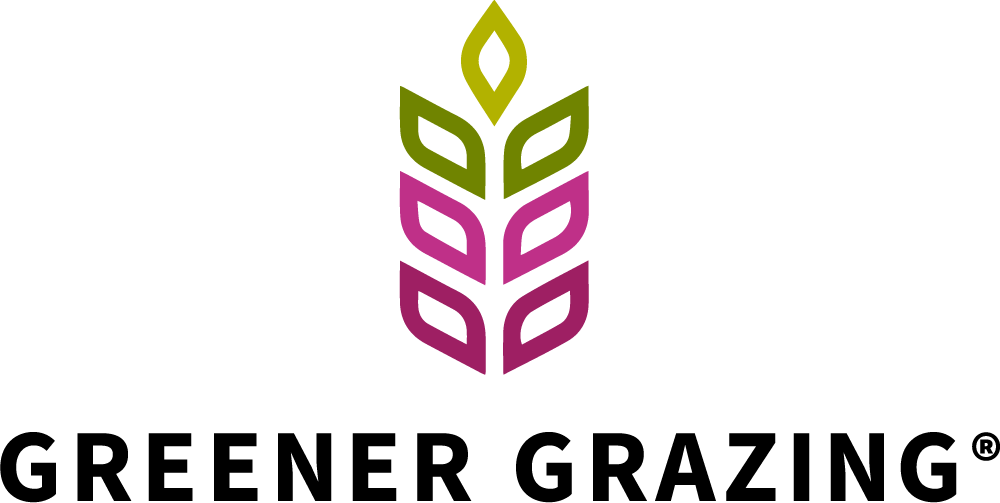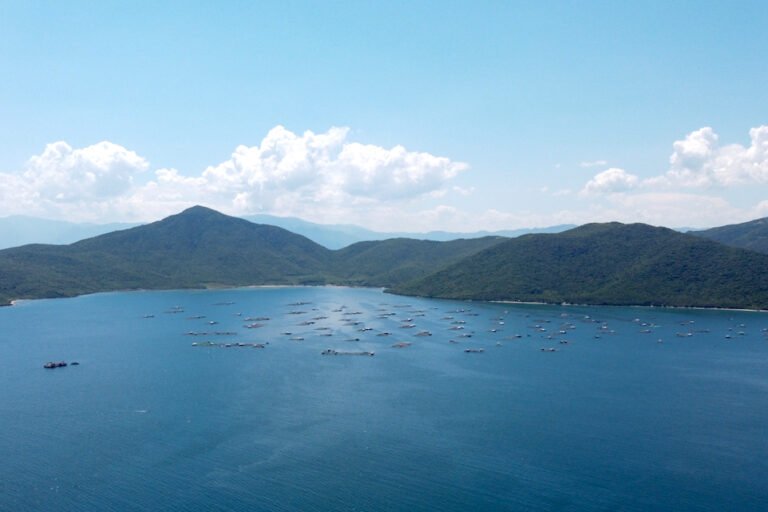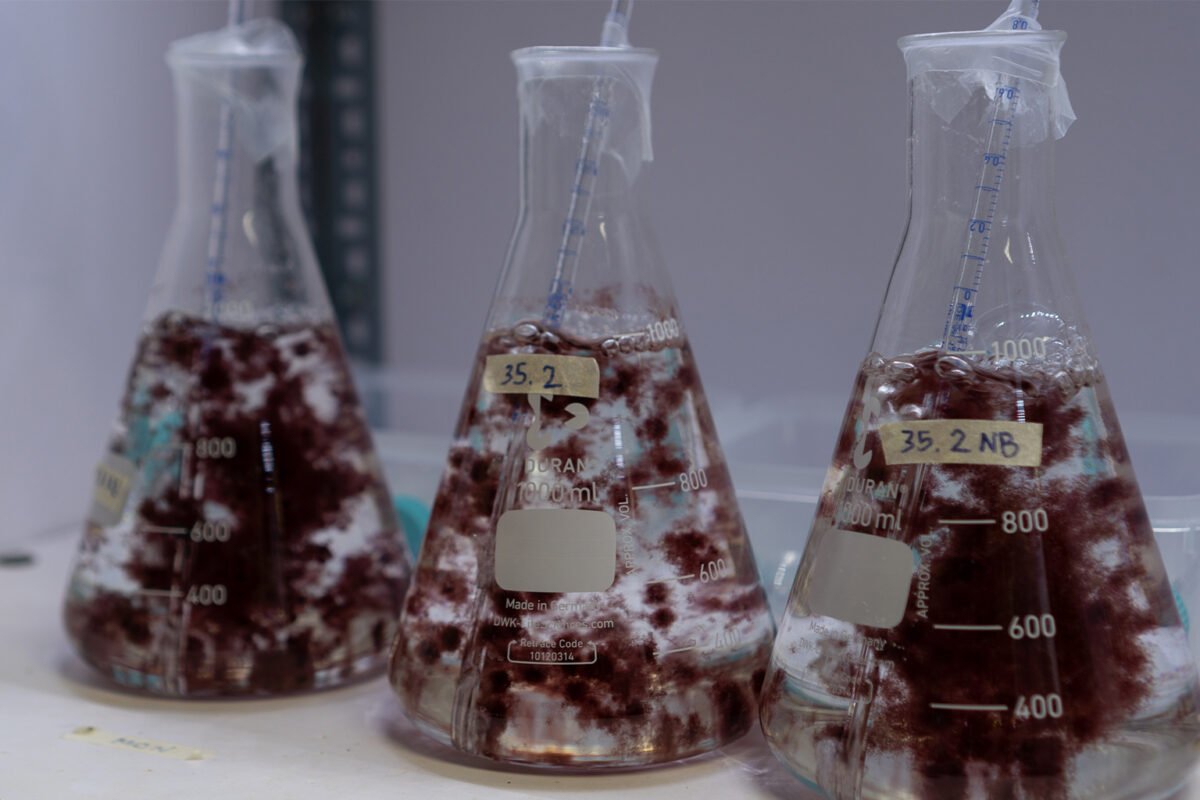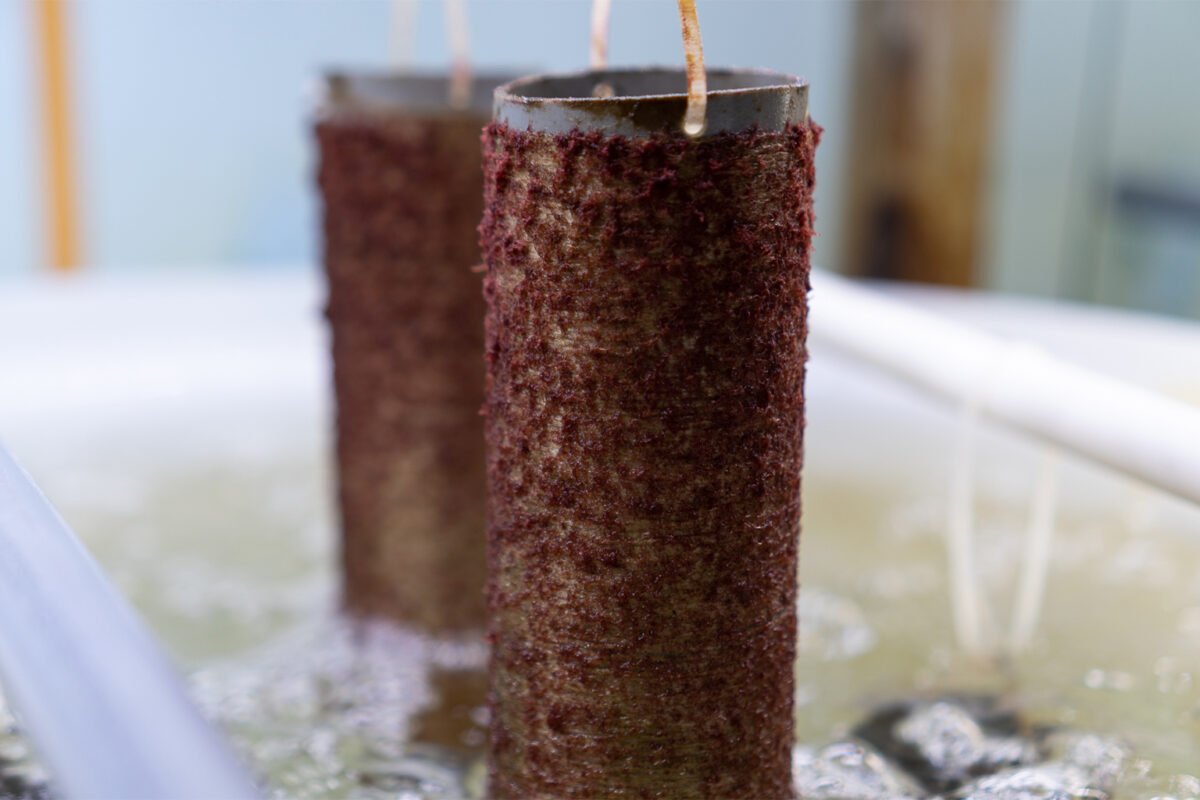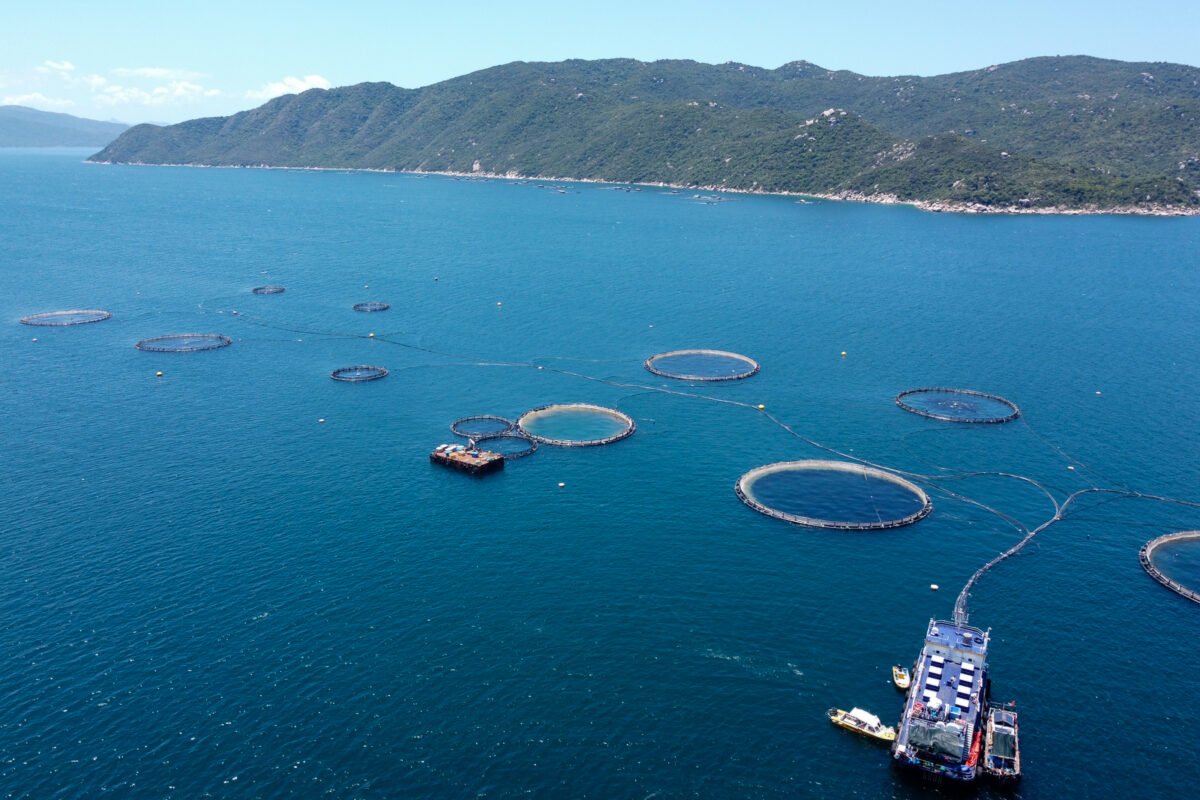An ‘aquatic moonshot’ in Vietnam aims to fight livestock methane with seaweed
Mongabay Series: Oceans
by Michael Tatarski on 11 October 2023
Scientists from the R&D company Greener Grazing aim to reduce global greenhouse gas emissions by growing and marketing a red seaweed (Asparagopsis taxiformis) as an additive for livestock feed.
Worldwide, some 3 billion cattle and sheep produce roughly 231 billion pounds of methane annually; researchers estimate some 100 million tons of A. taxiformis would be needed to eliminate 98% of those emissions, a figure that’s roughly three times current global production of all seaweeds.
Greener Grazing is experimenting with growing A. taxiformis in central Vietnam’s Van Phong Bay, but there are challenges.
Skeptics also say the benefits of seaweed are limited in both the amount of methane that can be reduced as well as the capacity for scaling production to meet the size of the problem.
VAN PHONG BAY, Vietnam — A bold mariculture experiment in this shimmering bay ringed by hills in central Vietnam is aiming to neutralize a globally significant source of greenhouse gas (GHG) emissions.
An international team of scientists at Greener Grazing, an R&D company, is growing a feathery, fern-like red seaweed called Asparagopsis taxiformis in a laboratory, with the aim of transferring the seaweed into the bay to grow fully.
In theory, Greener Grazing would then disseminate this know-how to farmers around the world, allowing local communities to grow, harvest and sell A. taxiformis for income as a climate solution.
This seaweed wouldn’t be for human consumption or use in cosmetics: It would be fed to livestock as a way to largely eliminate their methane emissions.
The challenge, however, is immense. There are nearly 3 billion cattle and sheep in the world and Greener Grazing estimates about 100 million tons of A. taxiformis would be needed as a feed additive annually to eliminate 98% of the roughly 231 billion pounds of methane these livestock emit each year.
In 2019, 34.7 million tons of seaweed were farmed globally — none of it A. taxiformis, according to the U.N. Food and Agriculture Organization (FAO). In this context, some researchers argue that this seaweed cannot practically be farmed at scale or have as large an impact as its promoters suggest.
A view of Van Phong Bay, with traditional aquaculture pens in the distance. Image by Michael Tatarski for Mongabay.
The foundational research
Greener Grazing’s work stems from a series of key research papers. In the first two, published in 2014 and 2015, scientists at James Cook University in Townsville, Australia, evaluated the impact of a total of 20 seaweed species on methane production in vitro by incubating seaweed samples with rumen fluid from cattle. They zeroed in on A. taxiformis as the best performer, with concentrations as low as 2% leading to a 99% drop in methane production in the 2015 paper.
The James Cook scientists then moved to in vivo research in collaboration with experts from the Canberra-based Commonwealth Scientific and Industrial Research Organisation (CSIRO). In 2016, they published a paper showing that A. taxiformis fed to live sheep at concentrations ranging from 0.5% to 3% reduced methane production by up to 80%.
By this point, these findings had caught the attention of Leonardo Mata, now Greener Grazing’s chief scientist, who had been a research fellow at James Cook from 2012 to 2014. He recalled thinking the above results were “remarkable.”
The research also attracted Josh Goldman, CEO of Australis Aquaculture, a Massachusetts, U.S.-headquartered company that is the world’s largest farmed-barramundi producer. Goldman saw a huge potential business opportunity and created Greener Grazing as a wholly owned subsidiary of Australis in 2018, with himself listed as project leader. The company operates out of Australis’s onshore research and production facilities on Van Phong Bay and uses space around the barramundi pens in the bay to experiment with the seaweed’s later life stages.
In 2020, specialists at James Cook and CSIRO delivered another blockbuster paper, this time showing that including A. taxiformis in live cattle feed at concentrations as low as 0.2% could eliminate up to 98% of enteric methane production.
The implications of these results are huge.
According to the FAO, the livestock industry is responsible for roughly 15% of global GHG emissions, largely thanks to enteric methane: cattle and sheep burping as they digest their feed. Methane, in turn, is 80 times more potent than carbon dioxide at trapping heat in Earth’s atmosphere. According to the Intergovernmental Panel on Climate Change, methane is responsible for a quarter of anthropogenic global warming.
Drawn by an expanding body of Asparagopsis research, a number of companies are attempting to address livestock emissions through seaweed in a commercially viable way. Greener Grazing’s peers include Blue Ocean Barns and Symbrosia, both based in Hawaii, Volta Greentech in Sweden, and SeaStock in Australia, each with their own approach. And in addition to its experiments in Vietnam, Greener Grazing also works with international research partners, such as the Dutch seaweed breeding company Hortimare.
The research challenge
In Van Phong, Mata and his team grow A. taxiformis, an organism with a highly complex life cycle, through its initial life stages onshore.
The seaweed begins in beakers in a hatchery as tiny, razor-thin strands called sporophytes (or more precisely, tetrasporophytes). After the strands grow into fuzzy clumps, they are moved to large containers or tanks in the nursery. There, the spores they release grow into strand-like gametophytes, the life stage that, when mature, is the algae’s feathery familiar form.
The idea is that the young gametophytes are then attached to ropes and transferred offshore to a site adjacent to Australis’s fish pens to mature.
That final life stage is the most challenging step, in part because of the location. For half the year, Van Phong Bay is too hot for A. taxiformis to grow.
Mata said his team can only attempt ocean production from November to March, as the species doesn’t grow well in water above 29° Celsius (84° Fahrenheit). They are currently exploring locations in northern Vietnam, where the water is cooler, to continue trials.
One research focus for Greener Grazing is a seed bank, which contains a library of roughly 800 A. taxiformis cultures from around the world, as the seaweed is present in more than 60 countries. This includes samples contained in Petri dishes in the hatchery from elsewhere in Vietnam, such as the island of Phu Quoc off the southwest coast, where sea temperatures are even higher.
“We know that the strains from Phu Quoc have a slight advantage when it comes to tolerance to higher temperatures,” Mata said. “However, we still don’t know for sure that this trait is transferred from the sporophyte to the gametophyte. It probably is, but we need to determine other important traits like its capacity to produce spores.”
This tolerance of heat, or lack thereof, has implications due to the very climate change Greener Grazing is attempting to address: In a warmer future, A. taxiformis would likely need to be grown in more temperate regions, as the tropics would become too hot for it to grow reliably.
“Another major challenge we’re facing is that the seaweed is not strongly attaching to the ropes,” Mata added. “So we can bring out ropes full of babies, but most of them detach, so at the end you don’t have a high-productivity rope.”
In the nursery, researchers are testing various materials to see if seaweed forms a strong attachment to a particular one. The company is also working with Gore, the creator of GORE-TEX, to produce a material that A. taxiformis firmly attaches to.
Land-based farming would be easier, but more energy-intensive while also requiring expensive facilities. In the ocean, seaweed can grow on its own with no need for nutritional inputs.
Seaweed farms can also offer some benefits to the local marine environment. According to the United Nations Environment Programme, ocean-based seaweed absorbs carbon dioxide while extracting dissolved nutrients from the water to counterbalance eutrophication. It can also provide a habitat for other marine organisms.
A rope of growing A. taxiformis. Image courtesy of Greener Grazing.
Scientific pushback
While A. taxiformis has generated ample excitement and drawn significant investment, it has some critics.
In a March 2021 Wired article, Matthew Hayek, an assistant professor in New York University’s Department of Environmental Studies who researches the environmental and climate impacts of food systems, and Jan Dutkiewicz, an assistant professor of political science at the Pratt Institute in New York who focuses on food production systems, rebutted the practicality of using the seaweed to dramatically reduce livestock methane emissions.
The authors wrote, “The truth is that the benefits of seaweed are likely far more limited, both in its capacity to reduce cows’ methane emissions and its potential to scale up to the size of the problem.”
In response to doubts that A. taxiformis farming can be sufficiently scaled, Mata said by email: “I always wonder what’s on the agenda behind serious scientists who argue this. Similar skepticism was also behind the cultivation of Porphyra (the sushi seaweed) until a British scientist cracked a critical stage of the seaweed complex life cycle and then farmers started to master the aquaculture at scale.”
Hayek and Dutkiewicz also argued that when it came to beef production, using A. taxiformis-supplemented feed was most practical on a feedlot, where cattle spend their last year or two in close proximity to each other to be fattened up before slaughter.
According to a 2019 study, 89% of the average cow’s methane production occurs before it reaches a feedlot. This means cattle emit most of their methane while at pasture, where it is more difficult to get them to eat additives.
When contacted to see if his views had evolved, Hayek told Mongabay, “Not only have my opinions not substantively changed, but new evidence shows that in new contexts, feeding A. taxiformis is even less effective than when I wrote the article.”
This evidence is from a 275-day Australian trial involving A. taxiformis extract in canola oil fed to cattle. The study, published by Meat & Livestock Australia, a marketing and research provider for the country’s red meat industry, found that the supplement generated a 28% decrease in methane production, well below the 98% that sparked so much interest.
Shorter trials using similar methods have returned more positive results, highlighting how this research is still very much a frontier.
Mata, in response to criticism that A. taxiformis will not have the type of global impact some suggest, acknowledged that daunting amounts of the seaweed would be needed to reach its maximum potential but said even smaller emissions reductions would be beneficial.
“But then what does global mean? And if not ‘global,’ then is it not worth pursuing?” he said. “I don’t believe in a one-solution-fits-all approach, and this is no exception – it is not going to save the world.”
Greener Grazing is experimenting with raising A. taxiformis seaweed near barramundi aquaculture pens belonging to parent company Australis in Van Phong Bay, Vietnam. Australis operates barramundi pens such as these at five sites in the bay. Image by Michael Tatarski for Mongabay.
The moonshot
Similarly, Greener Grazing’s website calls the project an “aquatic moonshot,” a term that contains both optimism and the possibility of failure.
“I’m pretty sure it will work, but I came here and came to the realization that there’s a lot of inconsistency and nuances that we need to master before we say we have a product with protocols we’re sure of,” Mata said.
In the meantime, Greener Grazing has attracted significant financial backing for further research. In late June, the Asian Development Bank announced a $3 million grant for the team to build new facilities and eventually go commercial. Martin Lemoine, unit head of the bank’s Food and Agribusiness Investment Team, emphasized the venture’s potential economic impact.
“This model will include local seaweed farmers arranged in clusters, while Greener Grazing’s hatcheries and nurseries will supply seeded ropes to farmers and then purchase their finished seaweed for processing at a local facility,” Lemoine told Mongabay. “Greener Grazing intends to include model farms within each farming cluster to demonstrate the production method, boost productivity, and support R&D. This provides an alternative species of seaweed for cultivation that can improve the livelihoods of seaweed farmers in Asia and the Pacific.”
As Mata put it, taking the first step toward that vision requires figuring out the formidable obstacle of the sea: “The ocean is the bottleneck.”
Banner image: The fern-like red seaweed Asparagopsis taxiformis in the wild. Image by Papahānaumokuākea Marine National Monument via Flickr (CC BY-NC 2.0).
Citations:
Machado, L., Magnusson, M., Paul, N. A., De Nys, R., & Tomkins, N. (2014). Effects of marine and freshwater Macroalgae on in vitro total gas and methane production. PLoS ONE, 9(1), e85289. doi:10.1371/journal.pone.0085289
Machado, L., Magnusson, M., Paul, N. A., Kinley, R., De Nys, R., & Tomkins, N. (2015). Dose-response effects of Asparagopsis taxiformis and Oedogonium Sp. on in vitro fermentation and methane production. Journal of Applied Phycology, 28(2), 1443-1452. doi:10.1007/s10811-015-0639-9
Li, X., Norman, H. C., Kinley, R. D., Laurence, M., Wilmot, M., Bender, H., … Tomkins, N. (2018). Asparagopsis taxiformis decreases enteric methane production from sheep. Animal Production Science, 58(4), 681. doi:10.1071/an15883
Kinley, R. D., Martinez-Fernandez, G., Matthews, M. K., De Nys, R., Magnusson, M., & Tomkins, N. W. (2020). Mitigating the carbon footprint and improving productivity of ruminant livestock agriculture using a red seaweed. Journal of Cleaner Production, 259, 120836. doi:10.1016/j.jclepro.2020.120836
Rotz, C. A., Asem-Hiablie, S., Place, S., & Thoma, G. (2019). Environmental footprints of beef cattle production in the United States. Agricultural Systems, 169, 1-13. doi:10.1016/j.agsy.2018.11.005
Effect of Asparagopsis extract in a canola oil carrier for long-fed Wagyu cattle. (2023). Retrieved from Meat & Livestock Australia Limited website: https://www.mla.com.au/contentassets/e4ce8f8ddb2743f38ac0f6e83a0724a3/p.psh.1353-mla-final-report-100723.pdf
Publication: MONGABAY.
